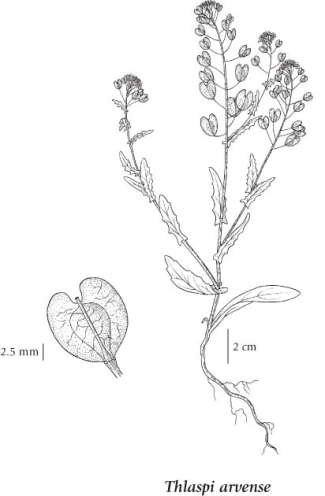Thlaspi arvense L.
field pennycress
Brassicaceae (Mustard family)
Introduction to Vascular Plants
field pennycress
Brassicaceae (Mustard family)
Introduction to Vascular Plants
Species Information
General:
Annual herb from a taproot; stems 10-50 cm tall, simple to freely branched, glabrous.
Leaves:
Basal leaves few, shed early, oblanceolate, 2-6 cm long, 1-2 cm wide, sinuate to almost lyrate, narrowed to short stalks, glabrous; upper stem leaves unstalked, with earlike lobes at the bases, lanceolate to oblanceolate, toothed to wavy-margined and lobed, glabrous.
Flowers:
Flower stalks widely spreading to upcurved, 7-15 mm long, slender; petals white, 3-4 mm long; sepals 1.5-2.2 mm long, glabrous.
Fruits:
Silicles, oval to nearly heart-shaped, 10-17 mm long, 9-15 mm wide, strongly obcompressed, slightly notched, sinus 1.5-2.5 mm deep, wing-margined all around; beaks 0.1-0.2 mm long; seeds about 2 mm long, concentrically corrugated.
Illustration

If more than one illustration is available for a species (e.g., separate illustrations were provided for two subspecies) then links to the separate images will be provided below. Note that individual subspecies or varietal illustrations are not always available.
Illustration Source: The Illustrated Flora of British Columbia
Ecology
Ecological Framework for Thlaspi arvense
The table below shows the species-specific information calculated from
original data (BEC database) provided by the BC Ministry of Forests and Range.
(Updated August, 2013)
The table below shows the species-specific information calculated from
original data (BEC database) provided by the BC Ministry of Forests and Range.
(Updated August, 2013)
| Site Information |
Value / Class |
||
|
Avg |
Min |
Max |
|
| Elevation
(metres) |
859 | 495 | 1530 |
| Slope
Gradient (%) |
5 | 0 | 18 |
|
Aspect (degrees) |
224 | 72 | 308 |
| Soil
Moisture Regime (SMR) [0 - very xeric; 4 - mesic; 8 - hydric] |
3 | 2 | 5 |
| Modal
Nutrient Regime
Class |
C | ||
| #
of field plots species was recorded in: |
10 | ||
| Modal
BEC Zone Class |
IDF | ||
|
All BEC Zones (# of stations/zone) species was recorded in |
IDF(5), MS(1), PP(3) | ||
|
Source:
Klinkenberg 2013
|
|||
Habitat and Range
Mesic to dry fields and waste places in the lowland, steppe and montane zones; common throughout BC except rare on the Queen Charlotte Islands and adjacent mainland; introduced from Eurasia.Status Information
| Origin Status | Provincial Status | BC List (Red Blue List) | COSEWIC |
|---|---|---|---|
| Exotic | SNA (2019) | Exotic | Not Listed |
BC Ministry of Environment: BC Species and Ecosystems Explorer.